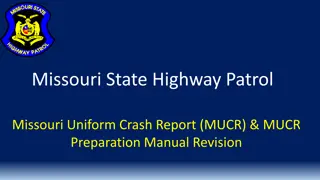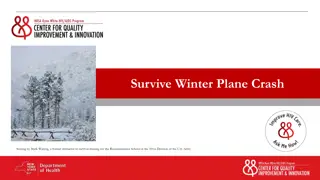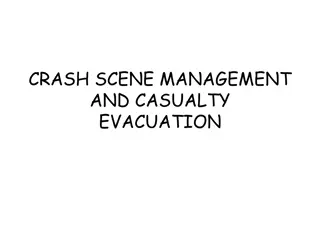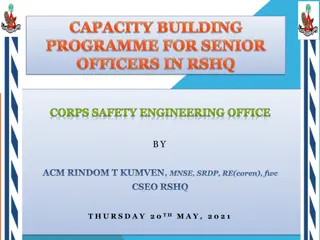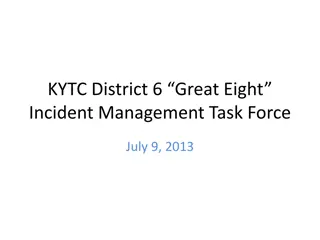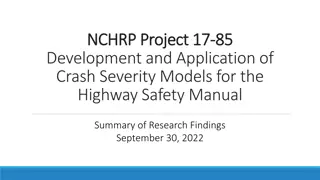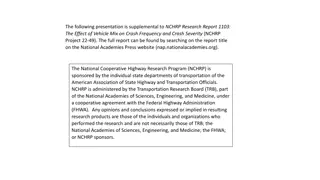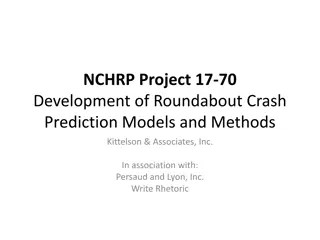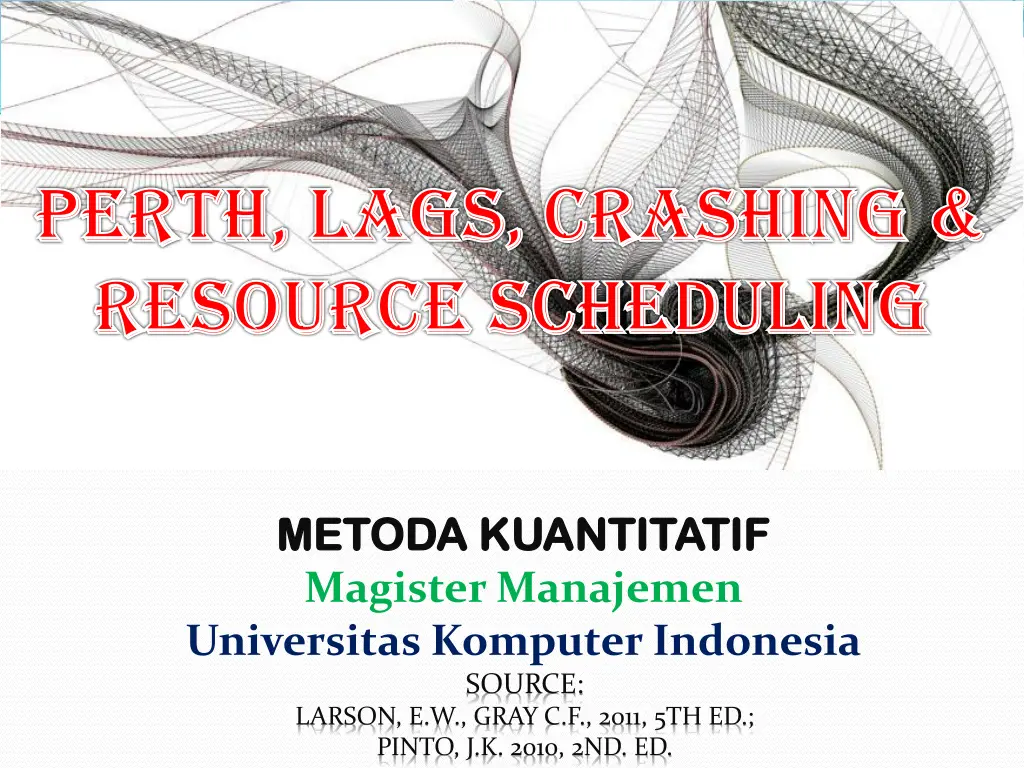
Understanding Resource Scheduling Methods in Project Management
Explore PERT, CPM, and project crashing techniques for efficient project planning and execution. Learn about activity time estimation, critical path duration, and probability analysis for completing projects on time.
Download Presentation

Please find below an Image/Link to download the presentation.
The content on the website is provided AS IS for your information and personal use only. It may not be sold, licensed, or shared on other websites without obtaining consent from the author. If you encounter any issues during the download, it is possible that the publisher has removed the file from their server.
You are allowed to download the files provided on this website for personal or commercial use, subject to the condition that they are used lawfully. All files are the property of their respective owners.
The content on the website is provided AS IS for your information and personal use only. It may not be sold, licensed, or shared on other websites without obtaining consent from the author.
E N D
Presentation Transcript
PERTH, LAGS, CRASHING & PERTH, LAGS, CRASHING & Resource SCheduling Resource SCheduling METODA KUANTITATIF METODA KUANTITATIF Magister Manajemen Universitas Komputer Indonesia SOURCE: LARSON, E.W., GRAY C.F., 2011, 5TH ED.; PINTO, J.K. 2010, 2ND. ED.
PROJECT PLANNING 1. Network Planning : Critical Path Method (CPM) Program/Project Evaluation and Review Technique (PERT) Precedence Diagram Method (PDM) 2. Project Crashing
PERT (PROGRAM EVALUATION & REVIEW TECNIQUE) In 1958 the Special Office of the Navy and the Booze Allen, and Hamilton consulting firm developed PERT to schedule the more than 3,300 contractors of the Polaris submarine project and to cover uncertainty of activity time estimates. PERT is almost identical to the critical path method (CPM) except it assumes each activity duration has a range that follows a statistical distribution.
Activity and Project Frequency Distributions Activity Project a m b TE
Weighted Average Activity (te) a + 4m + b = ------------- te 6 te a = weighted average activity time = optimistic activity time (1 chance in 100 compliting activity under normal conditions) = pesimistic activity time = most likely activity time b m
Activity Standard Deviation b - a te= ----- 6 TE= ( te)
Probability of Completing the Project in Time Ts TE -------------- ( te) Z = TE = Critical path duration TS = Schedule project duration Z = probability (of meeting scheduled duration) found in statistical
Z Values and Probabilities Z Value Probability Z Value Probability -3.0 .001 +0.0 .500 -2.8 .003 +0.2 .579 -2.6 .005 +0.4 .655 -2.4 .008 +0.6 .726 -2.2 .014 +0.8 .788 -2.0 .023 +1.0 .841 -1.8 .036 +1.2 .885 -1.6 .055 +1.4 .919 -1.4 .081 +1.6 .945 -1.2 .115 +1.8 .964 -1.0 .159 +2.0 .977 -0.8 .212 +2.2 .986 -0.6 .274 +2.4 .992 -0.4 .345 +2.6 .995 -0.2 .421 +2.8 .997
Example Activity a m b 1-2 17 29 47 2-3 6 12 24 2-4 16 19 28 3-5 13 16 19 4-5 2 5 14 5-6 2 5 8 1. Compute the expected time for each activity 2. Compute the variance for each activity 3. Compute the expected project duration 4. What is the probability of completing the project by day 67? Within 60 days?
ANSWER Actvity 1-2 2-3 2-4 3-5 4-5 5-6 a 17 6 16 13 2 2 m 29 12 19 16 5 5 b 47 24 28 19 14 8 te 30 13 20 16 6 5 ((b-a)/6))^2 25 9 4 1 4 1
Answer Hypothetical Network B D 13 16 0 A F C 30 5 E 20 6 Legend ES ID EF Description SL LS Dur LF
Answer - Probability Ts TE -------------- ( te) Z = 67 64 ----------------- 25 + 9 + 1 + 1 + 3 Z = = -------- = + 0.5 36 P = 0.69
Exercise 1 Given the project information below, what is the probability of completing the National Holiday Toy project in 93 time units? Act. ID Description Predecess or Optm.(a) Most Likely (m) Pess (b) 1 Design package None 6 12 24 2 Design product 1 16 19 28 3 Build package 1 4 7 10 4 Secure patent 2 21 30 39 5 Build product 2 17 29 47 6 Paint 3,4,5 4 7 10 7 Test market 6 13 16 19
LAGS IN PRECEDENCE RELATIONSHIP The term Lag refer to the logical relationship between the start and finish of another. In practice, lags are sometimes incorporated into networks to allow for greater flexibility in network construction. The commonly lags occur under four logical relationships between tasks: 1. Finish to start 2. Finish to finish 3. Start to start 4. Start to finish
CRASHING PROJECT At times it is necessary to expedite the project, to accelerate development to reach an earlier completion date. The process of accelerating a project is referred to as crashing. Crashing a project directly relates to resource commitment. The more resources we are willing to expend, the faster we can push the project to its finish.
Reasons to Crash a Project The initial schedule may be to optimistic. 1. 2. Market needs change and the project is in demand earlier than anticipated. 3. The project has slipped considerably behind schedule. 4. The contractual situation provides even more incentive to avoid schedule slippage.
Options for Accelerating Activities Improving the productivity of existing project resources. 2. Changing the working method employed for the activity, usually by altering the technology and types of resources employed. 3. Increasing the quantity of project resources, including personnel, plant, and equipment. 1.
Time-Cost Trade-Offs for Crashing Activities Crashed Point Crashed Cost Normal Point Normal Crashed Normal Time
COST OF CRASHING Crash Cost Normal Cost Slope = ------------------------ Normal Time Crash Time
EXAMPLE Calculate the cost of crashing project activities, suppose the normal activity duration of activity X is 5 weeks and is budgeted cost $12,000. The crash time for this activity is 3 weeks and is expected to cost $32,000.
Project Activities & Costs (Example) Activity Normal Crash Duration Cost Duration Cost A 5 days $ 1,000 3 days $ 1,500 B 7 days 700 6 days 1,000 C 3 days 2,500 2 days 4,000 D 5 days 1,500 5 days 1,500 E 9 days 3,750 6 days 9,000 F 4 days 1,600 3 days 2,500 G 6 days 2,400 4 days 3,000 H 8 days 9,000 5 days 15,000 TOTAL COST= 22,450 $ 37,500
Cost of Crashing Each Activity Activity Crashing Cost (per day) A $ 250 B 300 C 1,500 D 0 E 1,750 F 900 G 300 H 2,000
EXERCISE -2 You are considering the decission of whether or not to crash your project. After asking your operation manager to conduct an analysis, you have determined the crash activity duration and costs, shown in the table below (assume all activities are on the critical path): Activity Normal Crashed Duration Cost Duration Cost A 6 days $ 1,000 4 days $ 2,000 B 5 days $ 2,500 5 days $ 2,500 C 3 days $ 800 2 days $ 1,200 D 7 days $ 3,500 3 days $ 7,000 E 2 days $ 500 1 day $ 5,000 F 5 days $ 2,000 4 days $ 3,000 G 10 days $ 5,000 6 days $ 6,300 a. Calculate the per day cost for crashing each activity b. Which are the most attractives candidates for crashing? Why?
EXERCISE -3 Given the data and information that follow, compute the total direct cost for each duration. If the indirect costs for each project duration are $90 (15 time units), $70 (14), $50 (13), $40 (12), and $30 (11), compute the total project cost for each duration. What is the optimum cost-time schedule for the project? What is this cost? Act. Crash cost (slope) Maximum crash time Normal time Normal cost A 20 1 5 50 B 60 2 3 60 C 0 0 4 70 D 10 1 2 50 E 60 3 5 100 F 100 1 2 90 G 30 1 5 50 H 40 0 2 60 I 200 1 3 200
Exercise 3 - Network Model C F A 5 D G I B E H
Types of Resource Constraint 1. People 2. Material 3. Equipment
Resource- Constrained Schedule Sample 2 2 8 2 2P 2 6 5 8 4 6 10 2 1P 2 10 7 12 8 2 10 0 1 2 2 3 6 0 1P 0 0 2P 0 0 2P 0 10 2 12 6 6 10 0 2 2 2 4 6 0 1P 0 Legend ES ID EF 2 4 4 6 4 10 RES SL SL 6 1P 6 LS Dur LF 8 2 10
ES RESOURCE LOAD CHART I D R E S D U R E S L F S L 0 1 2 3 4 5 6 7 8 9 10 11 12 13 14 1 2P 2 0 2 0 2 2 2 2P 6 2 10 2 2 2 2 2 2 2 3 2P 4 2 6 0 2 2 2 2 4 1P 2 2 10 6 1 1 5 1P 2 6 10 2 1 1 6 1P 4 6 10 0 1 1 1 1 7 1P 2 10 12 0 1 1 Total resource load 2P 2P 5P 5P 4 P 4 P 4 P 4 P 1P 1P 1P 1P
RESOURCE CONSTRAIN SCHEDULE I D E S R R D U E S L F S L 0 1 2 3 4 5 6 7 8 9 10 11 12 13 14 1 2P 2 0 2 0 2 2 2 2P 6 2 10 2 2 2 2 2 2 2 3 2P 4 2 6 0 2 2 2 2 4 1P 2 2 10 6 1 1 5 1P 2 6 10 2 1 1 6 1P 4 6 10 0 1 1 1 1 7 1P 2 10 12 0 1 1 4P 4P 4P 4P Total resource load 2P 2P 5P 5P 1P 1P 1P 1P Resource available 3P 3P 3P 3P 3P 3P 3P 3P 3P 3P 3P 3P 3P 3P
RESOURCE CONSTRAIN SCHEDULE I D E S R R D U E S L F S L 0 1 2 3 4 5 6 7 8 9 10 11 12 13 14 1 2P 2 0 2 0 2 2 2 2P 6 6 12 0 2 2 2 2 2 2 3 2P 4 2 6 0 2 2 2 2 4 1P 2 2 10 6 1 1 5 1P 2 10 12 0 1 1 6 1P 4 6 10 0 1 1 1 1 7 1P 2 10 12 0 1 1 2P 2P 3P 3P Total resource load 2P 2P 3P 3P 3P 3P 3P 3P 1P 1P Resource available 3P 3P 3P 3P 3P 3P 3P 3P 3P 3P 3P 3P 3P 3P
New Resource Schedule Network 6 2 12 0 2P 0 10 5 12 6 6 12 0 1P 0 12 7 14 10 2 12 0 1 2 2 3 6 0 1P 0 0 2P 0 0 2P 0 12 2 14 6 6 10 0 2 2 2 4 6 0 1P 0 Legend 2 4 4 6 4 10 ES ID EF 0 1P 0 RES SL SL 10 2 12 LS Dur LF



